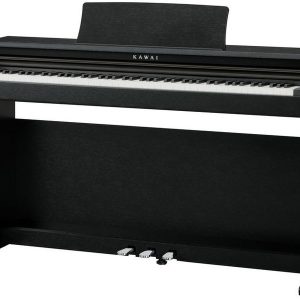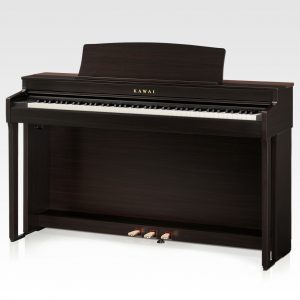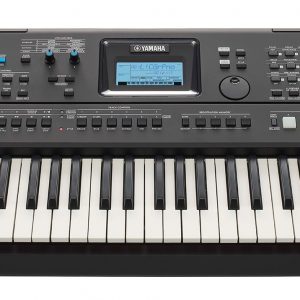Casio PX-S7000 Review
We rated the Casio PX-S7000 a 9.5 because of its combination of a heavy, authentic touch, rich honed-in tones, and its unique-yet-stylish build. The S7000 is a piece of beautiful craftsmanship and serves its intended audience well. It’s very similar to the S6000.
This model is meant to serve pianists who are looking for something high-end with many tones and is smart-device compatible.
My favorite features of the PX–S7000 are its unique design and updated sound system. While this model is much more pricey than the other instruments in this line, I believe it’s worth it.
I did end up taking off just a half of a point, due to the fact that this model has a bit less customizability than the PX-S6000. That being said, it trades this feature of a better grand piano and a new look.
$2,499.00
We rated the Casio PX-S7000 a 9.5 because of its combination of a heavy, authentic touch, rich honed-in tones, and its unique-yet-stylish build. The S7000 is a piece of beautiful craftsmanship and serves its intended audience well. It’s very similar to the S6000.
This model is meant to serve pianists who are looking for something high-end with many tones and is smart-device compatible.
My favorite features of the PX–S7000 are its unique design and updated sound system. While this model is much more pricey than the other instruments in this line, I believe it’s worth it.
I did end up taking off just a half of a point, due to the fact that this model has a bit less customizability than the PX-S6000. That being said, it trades this feature of a better grand piano and a new look.
Casio PX-S7000 Overview

The Casio PX-S7000 is a high-end digital piano from the Privia line. It was first released in September of 2022 and is the current flagship model. Like other PX-S models, the S7000 boasts a portable slimline design that artists can take with them anywhere. But if you ask me, the S6000 and S7000 models are standalone in both quality and design (more on the differences between these two later in this article).
The PX-S7000 costs significantly more than the other models in this line but has features like an improved speaker system, an extra grand piano, and more color options. Let’s get into it!
Features
A Head-Turning Yet Rugged Design
While some folks say that the Casio PX-S7000 boasts a contemporary design, I think it looks like it is straight out of the 1970s. The A-style legs are made of a lovely beech wood, and overall this model has a really peculiar yet sleek design.
Speaking of design, this model is super simple to put together and get on the stand. If you’re new to the digital piano world, that’s good news for you because Casio makes it easy to get the S7000 up and running. Though I might add that the S7000’s stand makes it feel more like a home digital that you can move around/ gig with rather than something that should be marketed as a portable portable model.
The legs are quite heavy, and the overall feel of the piano is that it’s durable and could handle years of wear and tear.
Unlike the PX-S6000 this model comes in multiple colors: black, white, and harmonious mustard. Some people say the combination of the design and the yellow make looks like a child’s piano, but I’m not sure I feel that way…While the mustard would have to be my least favorite of the 3, if your living room or music studio has a yellow flower power vibe, I could see it looking really nice. All aesthetic opinions aside, let’s get into the technical aspects of the instrument.
Smart Hammer Action Keybed
Like the PX-S6000 and PX-S5000 that were released alongside it, this model has something called Smart Hammer Action. SHM is a piece of Casio’s newest digital technology which allows for the instrument to have the best of both worlds: Portability, and a heavy hammer action touch.
The 6000 and 7000 models have keys that are made of a combination of wood and resin, resulting in a more convincing balanced feel than the lower-tier instruments from this line. This model has an action that is identical to the 6000- And to me, that’s a great thing.
Updated Sound System
Casio’s updated 4-speaker sound system is solidly built and has a satisfactory amount of power behind it.
Casio’s new Spatial Technology Sound System packs a big punch with its four full-range speakers. These speakers are securely surrounded by a housing made up of a combination of wood and composite. The speakers also have fabric covers which many pianists enjoy.
Piano Position
The sound of PX-S7000 can be optimized with a feature called Piano Position, which lets you tell the smart piano if your instrument is situated against a wall, or if it is on a table or in the middle of a room.
More Premium Pianos Than Ever Before
The premium voices are one of the best features of this model. These pianos have been sampled meticulously to get as authentic of a sound as possible.
The PX-S7000 has the same tones as the PX-S5000 and 6000, and then some. Some pianists prefer the S7000 model over the S6000 because of its new GR samples, while others actually perfect the onboard editability of the more economical S6000.
These newest samples include the PianoGR NY, and the PianoGR BN- the first being another Steinway sample and the second, being a Bechstein / German grand. Having these two tones adds to the timbral possibilities of the instrument. Both new samples are warm, well-rounded, pleasant, and bright-feeling.
400 Tones
This model has hundreds of tones, including professional organs, electric pianos, an excellent harpsichord sound, slapped bass, upright bass, and more. Most of these tones are click-and-go. That is, the voices don’t need to be tweaked, they sound excellent already.
3 Ways to Record
The instrument has a 2-track/5-song MIDI recorder as well as a USB memory recorder. The latter has a lot more room, with a maximum of 99 sounds and a recording limit of 25 minutes. There is also an internal flash memory, which also has a max of 99 songs.
Casio PX-S7000 Specifications

- Weight: 32.6 pounds
- Dimensions:
- Height: 4 inches
- Width: 52.7 inches
- Depth: 9.5 inches
Who is it Suitable for?
We’re not quite sure why Amazon has the PX-S7000 marked as a ‘beginner’ digital piano as this is anything but. While the PX-S1100 might fit into that category, it hardly feels like this model comes from the same line.
The S7000 is suitable for intermediate pianists and up. I’d recommend the PX-S line (as a whole) to pretty much any gigging pianist but the PX-S7000 does feel closer to a home piano than the PX-S6000 does. Then again, you don’t have to use the metal/wood stand it comes with, as the piano attaches to most standard stands (saying standard stands sounds funny…)
Other Notable Features
- Textured Keys
- Light-up controls light up
- Programmability
- Mic input, 25 mic effects
- Compatibility with Casio Music Space
- Key-off response
The Casio PX-S7000 has simulated ebony and ivory keys which grip the fingers ever so slight.
The controls are light-up and programmable. And, like the PX-S model below it, it has a ¼ inch mic input built into the back of the instrument. It is also compatible with Casio Music Space, of course, since it’s part of the hybrid smart piano line. I also thought it was worth mentioning that the instrument has key-off response, an aspect of VRM (virtual resonance modeling) which recreates the sound that felt falling onto the string makes after the key is released.
The PX-S7000 in Action
This all-playing, no-talking video created by Kraft Music will help you get introduced to the large soundbank that the PX-S7000 boasts.
While I could take or leave one of two or the organ sounds, the blues piano and traditional pianos truly impressed me. The bass/guitar sounds also have a surprisingly authentic twang that I couldn’t help but smile at.
Customer Reviews
This model has a rating of 5/5 stars on Amazon. However, there was only one review. Said review stated that the digital keyboard was “Fantastic!” and made them want to play- a lot.
I also delved into some forums online to see if there had been any glaringly obvious issues with the keyboard, but alas, I found nothing! It’s always a good sign when you dive deep into the web, and still can’t find any big cons.
Pros and Cons

Pros
- It has optional battery power for playing while out and about
- It has a mic input that makes it ideal for recording artists
- It has an included pitch bend wheel
- The spruce-composite keys feel heavy and high-quality
- The action is very quiet- quieter than most
- It’s completely driver-less
- It’s easy to navigate in live settings
- Many of the sounds are great (the piano, harpsichord, and string tones are phenomenal, and most of the organs are excellent)
I used to feel like ‘battery-powered digital pianos’ were a sign of a cheap or poorly-designed instrument, I’ve recently changed my mind. The PX-S7000 combines authenticity with ruggedness, resulting in an instrument that is both extremely sensitive and emotive, but also durable.
Cons
- This model is significantly more expensive than other PX-S pianos
- The buttons onboard are minimalist
- Not everybody is so gung-ho about the retro design
- You do lose some aspects of the PX-S6000
- The key feel is lighter than Roland’s (so Roland-lovers might not be big fans of the PX-S line)
- The stand is relatively easy to build, but takes time…You may want to go with another stand if you plan to gig with it (because who wants to be late for a gig?!)
I tend to prefer keyboards with lots of buttons- but this is a matter of personal preference. The PX-S7000 is retro yet minimalist and has a lighter key feel than Roland, but is much heavier than that of Yamaha’s GHS weight.
A lot of customers reported that the stand was really cool- but also took a long time to build. This is an important aspect to consider, especially if you’re a traveling musician.
Comparable Models
- For more flexibility in sound: PX-S6000
- For a step-down model: PX-S5000
As we mentioned earlier, the PX-S6000 is quite similar to the PX-S7000. But the two instruments aren’t without a handful of differences. For example:
- The 7000 model comes in 3 different colors whereas the 6000 only comes in black
- The 7000 has 3 premium grand whereas the 6000 only has 2 premium grands
- The panel in the 7000 model lights up whereas the 6000 models’ don’t
- PX S7000 has 50 more tones in the soundbank than the PXS6000
However, like the PX-S6000, this model has both a slimline design and the heft of real wood keys, which is a really difficult combination to find in the digital piano world. If you are looking more a more economical instrument, we also recommend the PX-S5000. If you choose a lower-tier PX-S than the S5000, though, it’s worth noting that you’ll lose a significant number of features.
Other instruments that are comparable include pianos from Roland, as well as Korgs such as the Nautilus. The weight of the touch between these three makers varies significantly. If I were to be extremely critical, I’d say that I feel that Roland’s heft is even more satisfying than that of the PX-S7000. Regardless, it’s still a great keyboard!
Quick View
| Keys | 88 keys with smart hammer action |
| Touch sensitivity | Yes: 5 settings, off |
| Sounds | 400 tones onboard |
| Recording capabilities | USB to MIDI/ USB audio recorder, MIDI recorder |
| Metronome | Yes |
| Polyphony | 256 notes |
| Speakers | 4 speakers |
| Headphones | 2 standard ¼ inch headphone jacks, 1 mini 1/8th inch jack |
| Accessories | Power supply, user manual
3-pedal unit and stand |
| Price point | $2,499.99 |
Casio PX-S7000 Conclusion
In conclusion, the Casio Privia PX S7000 is a stellar hybrid digital for the pianist who values tones and a hardy design. While you do lose some customizability in comparison to the step-down model, you get a sturdier chassis, an interesting new redesign, and new tones in exchange. This instrument is sleek, attractive, and (most importantly) it sounds wonderful.
So which model do you like better? Let us know in the comments!
Music quote of the week:
“Magic is what we do, music is how we do it.” -Jerry Garcia





 We rated the Casio PX-S7000 a 9.5 because of its combination of a heavy, authentic touch, rich honed-in tones, and its unique-yet-stylish build. The S7000 is a piece of beautiful craftsmanship and serves its intended audience well. It’s very similar to the S6000.
This model is meant to serve pianists who are looking for something high-end with many tones and is smart-device compatible.
My favorite features of the PX–S7000 are its unique design and updated sound system. While this model is much more pricey than the other instruments in this line, I believe it’s worth it.
I did end up taking off just a half of a point, due to the fact that this model has a bit less customizability than the PX-S6000. That being said, it trades this feature of a better grand piano and a new look.
We rated the Casio PX-S7000 a 9.5 because of its combination of a heavy, authentic touch, rich honed-in tones, and its unique-yet-stylish build. The S7000 is a piece of beautiful craftsmanship and serves its intended audience well. It’s very similar to the S6000.
This model is meant to serve pianists who are looking for something high-end with many tones and is smart-device compatible.
My favorite features of the PX–S7000 are its unique design and updated sound system. While this model is much more pricey than the other instruments in this line, I believe it’s worth it.
I did end up taking off just a half of a point, due to the fact that this model has a bit less customizability than the PX-S6000. That being said, it trades this feature of a better grand piano and a new look.




There are no reviews yet.